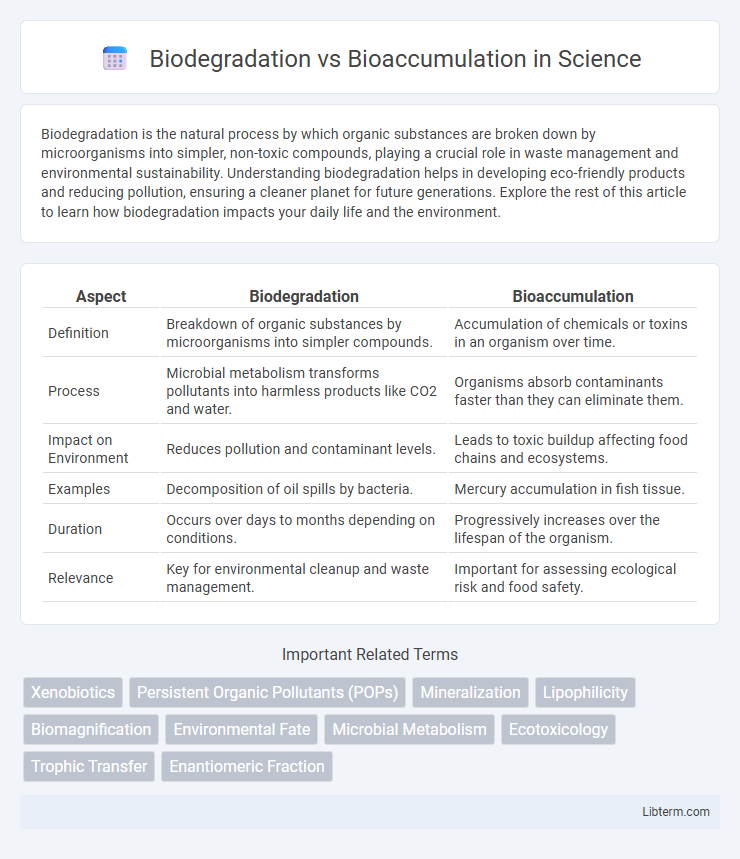Biodegradation is the natural process by which organic substances are broken down by microorganisms into simpler, non-toxic compounds, playing a crucial role in waste management and environmental sustainability. Understanding biodegradation helps in developing eco-friendly products and reducing pollution, ensuring a cleaner planet for future generations. Explore the rest of this article to learn how biodegradation impacts your daily life and the environment.
Table of Comparison
| Aspect | Biodegradation | Bioaccumulation |
|---|---|---|
| Definition | Breakdown of organic substances by microorganisms into simpler compounds. | Accumulation of chemicals or toxins in an organism over time. |
| Process | Microbial metabolism transforms pollutants into harmless products like CO2 and water. | Organisms absorb contaminants faster than they can eliminate them. |
| Impact on Environment | Reduces pollution and contaminant levels. | Leads to toxic buildup affecting food chains and ecosystems. |
| Examples | Decomposition of oil spills by bacteria. | Mercury accumulation in fish tissue. |
| Duration | Occurs over days to months depending on conditions. | Progressively increases over the lifespan of the organism. |
| Relevance | Key for environmental cleanup and waste management. | Important for assessing ecological risk and food safety. |
Introduction to Biodegradation and Bioaccumulation
Biodegradation refers to the natural process by which microorganisms break down organic substances into simpler compounds, reducing environmental pollutants and aiding ecosystem sustainability. Bioaccumulation describes the gradual buildup of toxic substances, such as heavy metals or persistent organic pollutants, in an organism's tissues over time, often leading to harmful biological effects. Understanding the mechanisms of biodegradation and bioaccumulation is crucial for managing environmental contamination and protecting biodiversity.
Defining Biodegradation: Natural Breakdown of Substances
Biodegradation is the natural process through which microorganisms such as bacteria and fungi break down organic substances into simpler compounds, reducing environmental pollutants. This process transforms complex pollutants into harmless products like carbon dioxide, water, and biomass, playing a crucial role in ecosystem health and waste management. Understanding biodegradation is essential to differentiate it from bioaccumulation, where contaminants build up in living organisms instead of breaking down.
What is Bioaccumulation? Understanding the Process
Bioaccumulation refers to the gradual buildup of toxic substances, such as heavy metals and persistent organic pollutants, in an organism's tissues over time. This process occurs when the rate of intake of these toxins exceeds the organism's ability to metabolize and eliminate them, leading to harmful concentrations that can affect health and reproductive success. Bioaccumulation is a critical factor in ecological risk assessments, particularly in aquatic ecosystems where contaminants biomagnify up the food chain.
Key Differences Between Biodegradation and Bioaccumulation
Biodegradation refers to the process by which microorganisms break down organic substances into simpler compounds, effectively reducing environmental pollutants, whereas bioaccumulation describes the buildup of toxic substances in an organism over time, often through the food chain. Key differences include biodegradation's role in decomposing contaminants and mitigating pollution, contrasted with bioaccumulation's potential to concentrate harmful chemicals, such as heavy metals and pesticides, in living tissues. Understanding these distinctions is crucial for environmental management strategies targeting pollution reduction and ecosystem health.
Factors Influencing Biodegradation in the Environment
Microbial activity, temperature, pH, and nutrient availability significantly influence biodegradation rates in the environment. Organic contaminants with simpler chemical structures undergo faster biodegradation compared to complex or recalcitrant compounds. Environmental factors like oxygen levels determine aerobic or anaerobic biodegradation pathways, impacting the overall breakdown efficiency.
Factors Affecting Bioaccumulation in Living Organisms
Bioaccumulation in living organisms is influenced by factors such as the chemical properties of substances, including hydrophobicity and persistence, which determine the tendency to accumulate in tissues. Biological factors like metabolic rate, age, and lipid content affect the extent to which organisms retain contaminants. Environmental conditions like temperature, pH, and availability of food sources also play a significant role in modulating bioaccumulation dynamics.
Environmental Impact: Biodegradation vs. Bioaccumulation
Biodegradation reduces environmental pollution by breaking down organic substances into harmless components through microbial activity, preventing toxic build-up in ecosystems. In contrast, bioaccumulation leads to the concentration of harmful chemicals, such as heavy metals and pesticides, in organisms, posing significant risks to wildlife and human health. The imbalance between these processes directly affects ecosystem stability, biodiversity, and the natural detoxification capacity of environments.
Human Health Implications of Bioaccumulation
Bioaccumulation refers to the gradual accumulation of toxic substances, such as heavy metals and persistent organic pollutants, in living organisms, posing significant risks to human health through contaminated food chains. These toxins can lead to chronic illnesses including neurological disorders, cancer, and endocrine disruption when they concentrate in human tissues over time. Understanding bioaccumulation is critical for assessing long-term exposure risks and implementing effective environmental and public health policies.
Promoting Biodegradation to Reduce Pollution Risks
Promoting biodegradation accelerates the natural breakdown of organic pollutants by microorganisms, effectively reducing environmental toxins and diminishing pollution risks. Enhancing microbial activity through biostimulation or bioaugmentation facilitates the conversion of harmful substances into harmless byproducts, preventing their accumulation in ecosystems. This process contrasts with bioaccumulation, where pollutants concentrate in organisms, posing long-term ecological and health hazards; therefore, advancing biodegradation is critical for sustainable pollution management.
Future Perspectives: Innovations and Research Directions
Emerging research explores advanced microbial consortia and genetically engineered enzymes to enhance biodegradation rates of persistent pollutants, aiming to mitigate environmental accumulation effectively. Innovations in nanoparticle-assisted bioremediation show promise in accelerating breakdown processes while minimizing bioaccumulation in aquatic and terrestrial ecosystems. Future directions emphasize integrating omics technologies and machine learning to predict biodegradation pathways and optimize bioremediation strategies for sustainable ecosystem management.
Biodegradation Infographic

 libterm.com
libterm.com